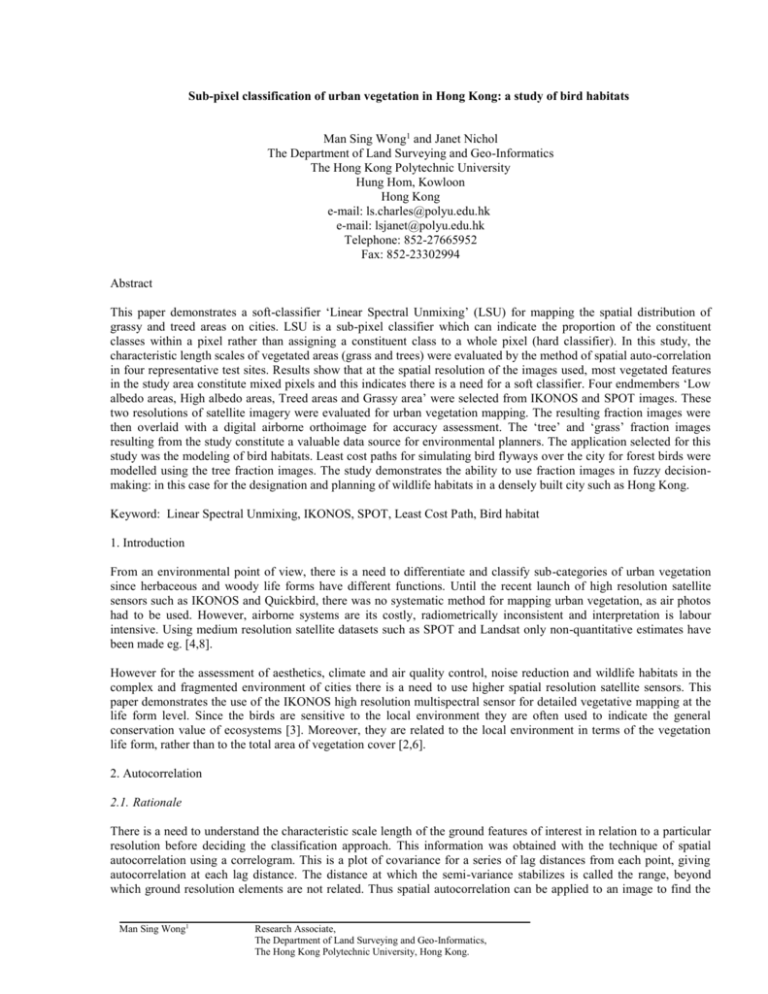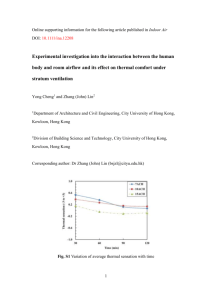Sub-pixel classification of urban vegetation in Hong Kong: a study of
advertisement

Sub-pixel classification of urban vegetation in Hong Kong: a study of bird habitats Man Sing Wong1 and Janet Nichol The Department of Land Surveying and Geo-Informatics The Hong Kong Polytechnic University Hung Hom, Kowloon Hong Kong e-mail: ls.charles@polyu.edu.hk e-mail: lsjanet@polyu.edu.hk Telephone: 852-27665952 Fax: 852-23302994 Abstract This paper demonstrates a soft-classifier ‘Linear Spectral Unmixing’ (LSU) for mapping the spatial distribution of grassy and treed areas on cities. LSU is a sub-pixel classifier which can indicate the proportion of the constituent classes within a pixel rather than assigning a constituent class to a whole pixel (hard classifier). In this study, the characteristic length scales of vegetated areas (grass and trees) were evaluated by the method of spatial auto-correlation in four representative test sites. Results show that at the spatial resolution of the images used, most vegetated features in the study area constitute mixed pixels and this indicates there is a need for a soft classifier. Four endmembers ‘Low albedo areas, High albedo areas, Treed areas and Grassy area’ were selected from IKONOS and SPOT images. These two resolutions of satellite imagery were evaluated for urban vegetation mapping. The resulting fraction images were then overlaid with a digital airborne orthoimage for accuracy assessment. The ‘tree’ and ‘grass’ fraction images resulting from the study constitute a valuable data source for environmental planners. The application selected for this study was the modeling of bird habitats. Least cost paths for simulating bird flyways over the city for forest birds were modelled using the tree fraction images. The study demonstrates the ability to use fraction images in fuzzy decisionmaking: in this case for the designation and planning of wildlife habitats in a densely built city such as Hong Kong. Keyword: Linear Spectral Unmixing, IKONOS, SPOT, Least Cost Path, Bird habitat 1. Introduction From an environmental point of view, there is a need to differentiate and classify sub-categories of urban vegetation since herbaceous and woody life forms have different functions. Until the recent launch of high resolution satellite sensors such as IKONOS and Quickbird, there was no systematic method for mapping urban vegetation, as air photos had to be used. However, airborne systems are its costly, radiometrically inconsistent and interpretation is labour intensive. Using medium resolution satellite datasets such as SPOT and Landsat only non-quantitative estimates have been made eg. [4,8]. However for the assessment of aesthetics, climate and air quality control, noise reduction and wildlife habitats in the complex and fragmented environment of cities there is a need to use higher spatial resolution satellite sensors. This paper demonstrates the use of the IKONOS high resolution multispectral sensor for detailed vegetative mapping at the life form level. Since the birds are sensitive to the local environment they are often used to indicate the general conservation value of ecosystems [3]. Moreover, they are related to the local environment in terms of the vegetation life form, rather than to the total area of vegetation cover [2,6]. 2. Autocorrelation 2.1. Rationale There is a need to understand the characteristic scale length of the ground features of interest in relation to a particular resolution before deciding the classification approach. This information was obtained with the technique of spatial autocorrelation using a correlogram. This is a plot of covariance for a series of lag distances from each point, giving autocorrelation at each lag distance. The distance at which the semi-variance stabilizes is called the range, beyond which ground resolution elements are not related. Thus spatial autocorrelation can be applied to an image to find the Man Sing Wong1 Research Associate, The Department of Land Surveying and Geo-Informatics, The Hong Kong Polytechnic University, Hong Kong. ideal spatial resolution ie. the lag distance which maximizes the variance between neighbouring pixels. The correlogram was produced using Moran’s I statistic [7]. It should be noted that the size and the characterisitcs of the sample areas and the ground variables being measured strongly affects the result of autocorrelation, and there is no unique correlogram for a whole city. Also, the selection of wavebands for computing autocorrelation is critical since urban areas comprise a diverse mixture of cover types. A range of scale lengths is typical for any city, according to its different districts, and Small [9] identified a range of 1020m for 14 urban areas worldwide using the NIR band, with the smaller cities toward the lower end of the range. Since this study is concerned with variably sized and often fragmented patches of vegetation, high spatial resolution was required for construction of the correlogram. Therefore, the IKONOS Panchromatic band with 1m spatial resolution was used to identify the typical scale length of urban surfaces and the NIR band of a false colour orthophoto of 0.5m resolution was used to identify scale lengths of vegetated surfaces. In order to avoid the possibility of local image variations being submerged in the global image variance, autocorrelation was applied to four different subregions of the study area representing increasing levels of urbanization. These were Ho Man Tin with extensive patches of remnant forest and large areas of recreational turf, the leafy suburban district of Kowloon Tong, the commercial region of Tsim Sha Tsui with some parks and street trees, and the high density commercial district of Mongkok almost devoid of vegetation. 2.2. Results Two distinct scale lengths were identified from the correlograms (Figure 1), at approximately 7-9m and 16-18m, since in all cases there is a distinct decline in the variance at 7-9m and the range is reached at 16-18m. These two scale lengths were identified as representing tree canopies and urban infrastructures respectively, in the study area. In reality, the grassy and treed areas tend occupy spaces between buildings and blocks, eg. sports pitches, and their scale length is influenced by the scale lengths of those urban features, with the exception of extensive vegetated areas such as parks. Although the two scale lengths identified are considerably larger than the IKONOS 4m pixels, they are of the same size order, resulting in a significant number of mixed pixels. For instance, the 4m² grid of IKONOS pixels overlaid on an 8m² grid and offset by 2m in X and Y would contain only 16 unmixed pixels out of a total of 64, and for a 16m grid 104 pixels out of a total of 256 would be mixed. At these scale lengths all SPOT pixels would be mixed. Figure 1. Correlogram of four test sites 3. Linear spectral unmixing 3.1. Rationale In the last decade, various studies have used image classification to map the general distribution of vegetation along with other urban cover types eg. [5,11]. However, the heterogeneity of urban land cover may create inaccurate results if conventional hard classifiers are used, and accuracy higher than 70% is rarely achieved. Based on the findings in section 2.2, that most IKONOS and SPOT pixels are mixed in urban Hong Kong, Linear Spectral Unmixing is proposed for vegetative life form mapping. The study area of the Kowloon Peninsula was selected since it is the largest continuous urban are in Hong Kong and contains a variety of cover types including commercial and residential areas of varying density, urban infrastructures, urban parks, forest, revegetated reclaimed land sites and sports pitches (Figure 2). Figure 2. Hong Kong outlines and study area The technique of LSU is theoretically capable of improving the spatial, and consequently, the spectral detail of entities being mapped instead of assigning a single class, as do conventional hard classifiers. A recent study found that threecomponent linear mixing model with Landsat TM imagery to be suitable for vegetation cover estimates of New York city using vegetation, high albedo and low albedo surfaces as endmembers [9]. However, due to shadowing within tree crowns at the scale of the 28.5m pixel size, trees were not separable from the low albedo component, and the vegetation endmember was exclusively represented by grass. 3.2. Applications Image-based end member selection was preferred in this study rather than from ground reflectance data, since ground reflectance data is site dependent, and the subsequent atmospheric normalization between ground and image data would introduce uncertainty. Thus, the spectral values of a total of 4 endmembers, including grass, trees, high albedo and low albedo surfaces were obtained from the images for the four multispectral IKONOS and three multispectral SPOT wavebands. The endmembers were obtained with the help of a high (0.35m) resolution colour digital orthophoto of October 2002, two years later than the IKONOS image, and one year before the SPOT image (Table 1). Homogeneous areas with large patches representing healthy grass and tree/shrub canopies were easily identified on the orthophoto using colour and texture, and manually digitized on the photo. More than 400 IKONOS pixels were used for each endmember, but only 50 for SPOT since it was more difficult to find large enough areas which were spectrally pure. In order to ensure high positional accuracy between the digital orthophoto and the IKONOS and SPOT images, the rigorous model [10] derived from orthorectification of the corresponding higher resolution panchromatic bands was applied to both SPOT and IKONOS images. The LSU technique requires that the number of bands should be equal to, or greater than the number of endmembers (in this case, 4). In order to maximize the spectral dimensionality of the data, a total of 6 spectral bands were used for IKONOS and 5 for SPOT. These included the original 4 IKONOS and 3 SPOT multispectral wavebands, plus the NDVI and the Green-Red ratio devised from the original data. The constrained LSU model was implemented to confine the output for the total of each pixel with a range between 0 and 1. Image details SPOT IKONOS Digital Orthophoto Wavebands (µm) Green: 0.43-0.47 Red: 0.50-0.59 NIR: 0.61-0.68 Blue: 0.45-0.52 Green: 0.52-0.60 Red: 0.63-0.69 NIR: 0.76-0.90 Panchromatic: 0.45-0.90 Blue Green Red Spatial resolution 20m Panchromatic: 1m Multispectral: 4m 0.35m Date 22.01.2003 23.11.2000 4.10.2002 Table 1. Image details 3.3. Results Surprisingly high accuracy was achieved, with higher than 80% accuracy between the resulting IKONOS fraction images against the reference data. Both grass and tree fraction results from 70 reference quadrats were highly correlated, with correlation coefficients of 0.97 and 0.98 respectively. Additionally, Figure 3 (a and b) show that a total of 61 out of 70 reference samples lies with + and – 0.1 fraction range, giving 87% accuracy within the 90% confidence limit. Thus the fraction images are strong indicators of the actual ground areas of grass and trees respectively. The grass and tree fractions from SPOT were less highly correlated with the reference plots, attaining correlation coefficients of 0.85 for grass and 0.80 for trees although the relationship is still reasonably good. Referring to Figure 4b, since 36 out of 60 points for trees lie within a 0.1 fraction threshold, then we have 60% confidence that each pixel lies within 10% of the actual amount of trees. For grass, 40 out of 60 points lie within the 0.1 fraction threshold, thus we have 67% confidence for grass estimates (Figure 4a). Figure 5 (a and b) shows the greyscale images of the study area for grass and tree fractions. The fraction value ‘1’ is represented by white colour and ‘0’ is represented by black color. These images provide a broad overview of detailed bird habitats extending from forested mountain slopes in the north, to the southern tip of the Kowloon Peninsula. Tree cover is abundant on steep slopes in the centre of the peninsula, while peripheral areas are only sparsely forested. Grass cover is typically found on sports pitches, and on the West Kowloon reclaimed land site, much of the latter being temporary open space awaiting development. There is also some spontaneous invasion of this reclaimed land by coastal tree species, creating a rich semi-natural habitat. However, the image shows almost total isolation of this area from other well-vegetated sites in the north, centre and south of Kowloon Peninsula. a. Figure 3. Scatter plots of fraction values from IKONOS image against reference data (orthophoto) (a) Grass and (b) Tree. a. Figure 4. b. b. Scatter plots of fraction value from IKONOS image against the reference orthophoto, (a) Grass and (b) Tree. a. Figure 5. b. Fraction image from IKONOS: (a) Grass; (b) Tree 4. Bird habitat modeling A significant relationship (R2=0.69) was established between the distance of urban parks in Hong Kong from the nearest countryside, and bird species richness in the parks [6]. If the countryside is considered to be a source area, this suggests that non-forested areas constitute a barrier to dispersal, and the presence and abundance of forest birds in urban parks may depend on the occurrence of pure, uninterrupted tree cover in the intervening areas. Three models were constructed using the tree fraction image to plot the potential dispersal routes for forest birds from the nearest forested region at the northern edge of Kowloon Peninsula to the 14 ha. Kowloon Park near the southern tip of the Peninsula. A total of 87 species of birds have been observed in this park, which is surrounded by one of the most densely populated urban areas in the world [6]. Three different reclassification and weighting schemes were devised (Table 2), and three different paths were output from these varied weightings (Figure 6). The first set of weights (A) considers birds which prefer dense tree cover but which could also tolerate lesser amounts, albeit as a lower preference. Thus for Model A, the friction weights were set to gradually increase as the percentage of tree cover decreased. In model B, high friction values have been given to all pixels except those with a tree fraction value of 0.8-1, and this simulates a route favoured by birds which require a thick tree cover and cannot tolerate a sparse canopy. Model C, where the friction values of all pixels containing a tree fraction are set equal, represents the shortest path followed by bird species which simply require tree cover along the route but the patch size is not a limiting factor. a. Fraction (From) 0.8 0.6 0.4 0.2 0 Fraction (To) 1 0.8 0.6 0.4 0.2 Friction Value 5 10 20 50 100 b. Fraction (From) 0.8 0.6 0.4 0.2 0 Fraction (To) 1 0.8 0.6 0.4 0.2 Friction Value 5 50 50 50 50 c. Fraction (From) 0.8 0.6 0.4 0.2 0 Fraction (To) 1 0.8 0.6 0.4 0.2 Friction Value 10 10 10 10 100 Table 2. Weights for three least cost routes simulation, (a) Model A, (b) Model B and (c) Model C. Figure 6. Simulated least cost routes 5. Conclusion The results show a very strong relationship between the fraction images devised from LSU and the actual areas of grass and trees on the ground. This high accuracy (87% confidence that fractions lie within 10% of the actual amount) which was maintained even for pixels containing both grass and trees was surprising, given the spectral overlap between trees and grass in some wavebands, ie. only the NIR band in IKONOS image, of the 6 band used in the study showed a significant spectral difference between grass and trees. The lower accuracy obtained from SPOT images was expected due to its lower spatial resolution and the very small sizes of vegetation patches in the study area. This study also demonstrates the importance of preliminary analysis of the scale lengths of target features compared with the dataset resolution, using techniques such as spatial autocorrelation, for determining the best classification approach Additionally, this study illustrates the ability to use the resulting fraction images as a direct input to fuzzy decision making, since the major advantage of the LSU model is that the resulting fractions may be combined in different ways depending on the scale of information required. For instance, the fraction data can be scaled up to produce very accurate regional estimates, or scaled selectively according to the minimum patch size required at a particular landscape level. Alternatively, weights can be allocated according to expert opinions, as demonstrated in this study for the case of bird migration and dispersal routes, which combines the fractions of individual pixels at local level with an enquiry at regional level. Such queries can be used to test unknown hypotheses in ecology such as whether local effects on birds also apply at larger spatial scales [2]. References [1]. [2]. [3]. [4]. [5]. [6]. [7]. [8]. [9]. [10]. [11]. Adams, J. B., Smith, M. O., & Johnson, P. E. (1986). Spectral mixture modeling: a new analysis of rock and soil types at the Viking lander. Journal of Geophysical Research, 91, 8098-8122. Blair, R. B. (1996). Land use and avian species diversity along an urban gradient. Ecological Applications, 6, 506-519. Briffet, C. (1990). Master plan for the conservation of nature in Singapore. Malayan Nature Society (Singapore Branch), Singapore. Fung, T., & Siu, W. L. (2001). A study of green space and its changes in Hong Kong using NDVI. Geographical and Environmental Modelling, 5(2), 111-122. Gao, J., & Skillcorn, D. (1998). Capability of SPOT XS data in producing detailed land cover maps at the urban-rural periphery. International Journal of Remote Sensing, 19(15), 2877-2891. Lock, N. Y. (2001). The ecology of urban birds in Hong Kong. Unpublished PhD thesis, University of Hong Kong. Moran, P. A. P., 1950. Notes on continuous stochastic phenomena. Biometrika 37:17-23. Nichol, J. E. (1996). High resolution surface temperature patterns related to urban morphology in a tropical city: a satellite-based study. Journal of Applied Meteorology, 35(1), 135-146. Small, C. (2001). Estimation of urban vegetation abundance. International Journal of Remote Sensing, 22(7), 1305-1334. Toutin, T., & Cheng, P. (2000). Demystification of IKONOS, Earth Observation Magazine, 9(7), 17-21. Weng, Q. (2001). A remote sensing-GIS evaluation of urban expansion and its impact on surface temperature in the Zhujiang Delta, China. International Journal of Remote Sensing, 22(10), 1999-2014.








